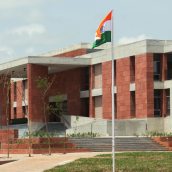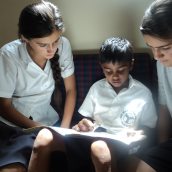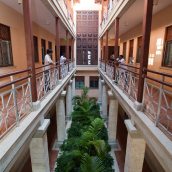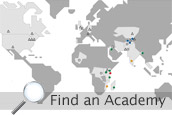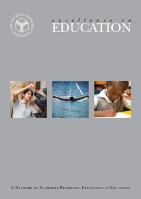The start of the Aga Khan Academies network
For the most part, high-quality schools around the world operate independently. The Aga Khan Academies (AKA), however, are working towards becoming an integrated network of 18 residential institutions across 14 countries in four regions of the world. The network of Academies will bring together girls and boys who are selected on merit, irrespective of socio-economic background, building the next generation of globally-competitive, locally-relevant, and ethically-sound leaders. In this network of schools, larger concepts and ideas are conceived of, shared, and tested at a global level, and then contextualised for the local situation. This approach is exceptional in the world of education, and the opening of the Academy in Hyderabad is allowing for this bold vision to be realised.
The benefits of the network
Why an integrated network instead of a set of affiliated schools? In a recent interview, AKA Director Salim Bhatia made it very clear: a network of schools enables innovation in education and pedagogy across a wider community of learners in diverse settings. It also fosters a sense of global connection amongst students, faculty, and staff.
A year 1 student reads with two year 6 Tajik students. Before the start of the network, the diversity of the Mombasa campus was broadened with the arrival of eight students from Tajikistan.The world is rapidly globalising. The network of Aga Khan Academies takes advantage of the trend of globalisation by bringing together children and educators from all corners of the world and from very diverse backgrounds to create a wide-reaching learning community. Children of successful industrialists and rural farmers, from pastoral north-east Kenya to Moscow far to the north, all live and learn together. These students are given the tools and the opportunity to work through diversity and difference and achieve group and individual successes.Students from the first Aga Khan Academy in Mombasa are already appreciating this. Academy graduate Elias Okwara notes, “The exposure to pluralistic ideals I received at the Academy helps me in engaging with individuals who have different perspectives.”
Bhatia shared a vision of a network of schools that emphasise experience-based education over classroom learning alone. At these schools, students and faculty collaborate across borders with their peers in other parts of the world. At any given time, around 10 per cent of the student population will be on exchange from another Academy, creating many opportunities for students to practice living and working with people from a variety of geographical, ethnic, and socio-economic backgrounds.
The Academies are also taking a global perspective on staff collaboration. Staff and experts from across the globe – for example a curriculum manager or language-learning specialist – will work together with colleagues in different Academies. This wider approach to human resources ensures that appropriate staff and faculty can bring their particular expertise to bear across the network, and that expertise can be leveraged in a way that would not be feasible or cost-effective in a single school.
The beginnings of the network
The opening of the Academy in Hyderabad has allowed Bhatia and his team to test the benefits and features of this integrated network approach, and so far the results have been positive. The core team of educators is working to actualise the vision of an integrated network within the individual Academies. Students are slowly realising that their peer group of Academy students extends across national boundaries.
Having teachers from varied backgrounds brings the strength of diversity to the Academies' faculty.The network has been beneficial for professional development as well. There have been a number of visits of staff from Hyderabad to Mombasa and vice-versa, where the staff have been able to interact with their colleagues and share best practices. Last August, a long-serving teacher from the Academy in Mombasa opted to move to Hyderabad as a member of the founding team of teachers there. Other Hyderabad staff joined the Academies network, having been drawn by the vision. One of these is mathematics lead teacher Karim Ismail-Charania, originally from London, UK, whose experience had been shaped by working in classrooms of 90 or more students in Uganda: "At the very core of the Academies programme, there is a vision to change the educational reality in some of these countries. The opportunity to participate in this, at the nascent stage of engineering the curriculum whilst the very school I am to work in is built around me, is one I am unlikely to be presented with many more times in my career. Supplement this with the dual nature of the role that allows you to contribute to educational development in the wider locality through outreach work with teachers and students in neighbouring schools, and you find yourself teaching in a truly unique environment."Students and classrooms
The first students at the new Aga Khan Academy in Hyderabad get to know their peers.Finding the right students for the Aga Khan Academies is a rigorous process, and the admissions staff in Hyderabad have learned a lot from Mombasa's admissions team. The selection process is being refined on an ongoing basis to ensure that students have both the capacity and desire to succeed academically, personally, and professionally, as well as the potential to become leaders who can effect positive change in their societies.At the classroom level, the beginnings of a network have begun to reflect on pedagogy and the development of curricular materials tailored for the Academies. Curriculum development work is underway in both Mombasa and Hyderabad on the Aga Khan Curricular Strands (AK Strands). These are areas of focus that foster understanding and attitudes related to Ethics, Pluralism, Cultures (with an emphasis on Muslim civilisations), Governance and Civil Society, and Economics for Development.
The AK Strands use interesting, locally-relevant content to illustrate concepts that are being taught network-wide. For example, year 3 students in India worked on a history and geography unit about Hyderabad, that related to Economics for Development, in which they examined how the physical features of the area influenced the city and its economic activity. They learned about employment today and also looked at traditional forms of work, including a visit to a nearby weaving co-operative. This unit helped the students understand both general ideas about economics and their impact on daily life in Hyderabad.
The future of the network
Starting a network, even with just two schools at first, is not an easy task. Bhatia acknowledges that there have been challenges, and certain considerations come into play that would not be present for a single school.
Friendships formed across cultures and regions help build understanding and long-lasting bonds.The first and largest of these is navigating the balance between standardisation and contextualisation – between the global and the local. A properly integrated network where educators work together to create curriculum materials and lesson plans, where students and faculty travel between Academies, and where everyone leverages technology to work together requires a set of standards to make collaboration possible. At the same time, good education is contextualised to the time, place, and situation of the school. The staff at the Aga Khan Academies are working to negotiate the right balance between the local and the global.“The best teaching and learning emerges from diverse teams working towards a common goal – in the case of the Academies, the notion of a team extends beyond any given campus or national boundary,” says Craig Bradley, Senior Manager for Strategy and Planning, Academies Unit.
There are, of course, logistical challenges that come from an increased roster of schools. With application and enrolment numbers rising, school management faces the challenges of finding appropriately qualified faculty and staff, based on standards set at the network level.
Residential students from within the region and from other Academies are housed in secure and well-supervised accommodation.While the Academies recruit staff from across the world, they also work at building local capacity to teach at the highest international standards. Building quality and competency in the teaching faculty is a central concept of the network. Intensive work is being done to create processes and systems for collaborative pedagogy, staffing, and professional development. These systems are already being tested and show promise for the future operation of the network. An exchange programme for both students and faculty is being developed, and the Academies Unit is establishing new procedures for teacher development and appraisal that can be adopted for all the Academies.There is a lot more work to be done, but there is promise for the future. The opening of the Academy in Hyderabad was the first step in the creation of an integrated network of Academies, and the first step in a unique concept in education that fosters innovation and excellence.
Newsletter readers please click here to return to the newsletter (browser version)
publications


